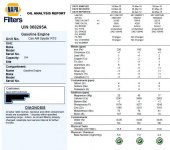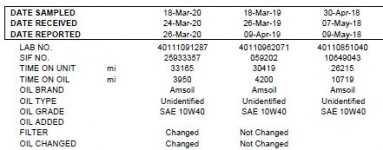SportsterDoc
Member
Lot of good background in post 20, Ron...may explain a lot.
My rough guidelines remain:
Dino oil: 3K intervals
Synthetic blend: 4K intervals
Pure synthetic: 5K intervals
No way I am going 6K or more between oil changes, even with pure synthetic.
I would have done the first change by now, but the factory oil still looks new. I do plan to switch to 10W50 Castrol synthetic by summer.
Factory oil is rated, per the manual, up to 104 F and I have been in 111 F already, but not high speed or long distance.
Most of my M/C served well with Castrol 20W50, both Sportsters used H-D 360 (no particular good reason) and the Moto Guzzi Motoul 10W60.
My first synthetic experience was Castrol 20W50 in the Bonneville. With an oil cooler and twin oil pumps, although air cooled, never behaved hot, even across the desert from LA to Las Vegas in the summer and a ~500 mile one day trip on the Extraterrestrial Highway loop.
Not pushing Castrol, but do recommend selecting a quality brand, then continue with same.
In 1977, I sold a 71 Chevrolet Chevelle Malibu to a friend. I had used only 10/30 Quakerstate, since new; but my friend liked Castrol (which I have mainly used for Japanese bikes). He switched, but complained that it was using oil. The 307 (Quad carb, aluminum high rise manifold, Hooker headers, aftermarket dual exhausts) had about 70,000 miles, but no oil consumption could be noted on the dip stick, between 3,000 mile interval oil changes.
After a couple years, he in turn sold it to a mutual friend, who went back to the original oil and then had no notable consumption between oil changes. Did the additives conflict?
My rough guidelines remain:
Dino oil: 3K intervals
Synthetic blend: 4K intervals
Pure synthetic: 5K intervals
No way I am going 6K or more between oil changes, even with pure synthetic.
I would have done the first change by now, but the factory oil still looks new. I do plan to switch to 10W50 Castrol synthetic by summer.
Factory oil is rated, per the manual, up to 104 F and I have been in 111 F already, but not high speed or long distance.
Most of my M/C served well with Castrol 20W50, both Sportsters used H-D 360 (no particular good reason) and the Moto Guzzi Motoul 10W60.
My first synthetic experience was Castrol 20W50 in the Bonneville. With an oil cooler and twin oil pumps, although air cooled, never behaved hot, even across the desert from LA to Las Vegas in the summer and a ~500 mile one day trip on the Extraterrestrial Highway loop.
Not pushing Castrol, but do recommend selecting a quality brand, then continue with same.
In 1977, I sold a 71 Chevrolet Chevelle Malibu to a friend. I had used only 10/30 Quakerstate, since new; but my friend liked Castrol (which I have mainly used for Japanese bikes). He switched, but complained that it was using oil. The 307 (Quad carb, aluminum high rise manifold, Hooker headers, aftermarket dual exhausts) had about 70,000 miles, but no oil consumption could be noted on the dip stick, between 3,000 mile interval oil changes.
After a couple years, he in turn sold it to a mutual friend, who went back to the original oil and then had no notable consumption between oil changes. Did the additives conflict?



